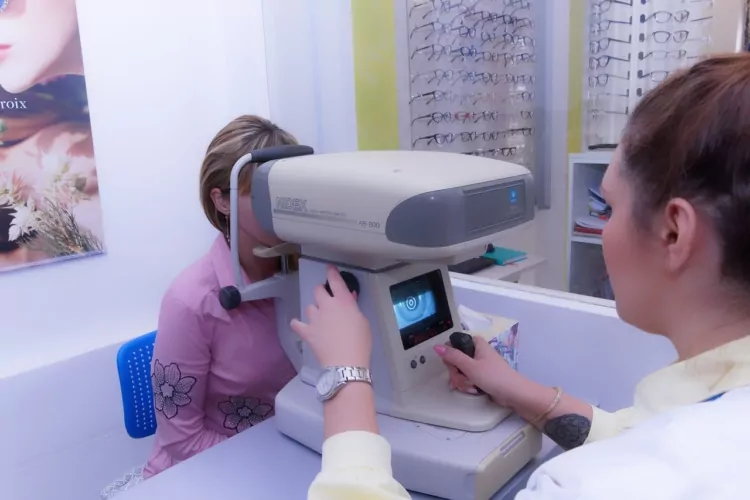Eyesight deteriorates with age due to various physiological changes in the eyes. While gradually deteriorating eyesight is a natural part of ageing and affects most people, changes in eyesight during one’s 20s and 30s can be more concerning. If you are concerned about your eyesight getting worse, Optegra is a group of dedicated eye hospitals located nationwide. We can help restore your eyesight through many tailored vision correction treatments, including laser eye surgery, lens replacement, and cataract surgery.
Is Bad Eyesight Genetic?
Poor eyesight can have a genetic component, meaning that certain vision problems may run in families. Common genetic factors include the predisposition to refractive errors such as myopia (nearsightedness), hyperopia (farsightedness), or astigmatism. Some eye diseases, like glaucoma and age-related macular degeneration, also have a genetic link. If a person has a family history of certain eye conditions, they may be at a higher risk of developing similar issues.
Environmental Factors
In addition to genetic factors, environmental influences play a significant role in eye health.
Digital Eye Strain: Prolonged use of digital devices, such as computers, smartphones, and tablets, can contribute to digital eye strain. Staring at screens for extended periods may cause symptoms like eye fatigue, dryness, and blurred vision.
UV Exposure: Long-term exposure to ultraviolet (UV) rays from the sun without proper eye protection can increase the risk of cataracts and other eye conditions.
Poor Nutrition: A diet lacking in essential nutrients, such as vitamins and minerals, can negatively impact eye health. Nutrients like vitamin A, vitamin C, and omega-3 fatty acids are particularly important for maintaining good vision.
Smoking: Smoking has been linked to an increased risk of several eye conditions, including cataracts, macular degeneration, damage to the optic nerve, and ocular cancers.
Lack of Physical Activity: Sedentary lifestyles may contribute to conditions like obesity and diabetes, which can have negative effects on eye health.
Poor nutrition is linked to deteriorating eyesight

Healthy Lifestyle and Eye Health
While genetics play a role, adopting a healthier lifestyle can contribute to better overall eye health and potentially reduce the risk of certain eye conditions. This includes:
Balanced Diet: Consuming a diet rich in fruits, vegetables, and foods high in vitamins and minerals is beneficial for eye health.
Regular Exercise: Physical activity is linked to a lower risk of conditions like diabetes and obesity, which can have positive effects on eye health.
UV Protection: Wearing sunglasses that block harmful UV rays can help protect the eyes from conditions associated with UV exposure.
Regular Eye Checkups: Routine eye exams can detect issues early on, allowing for timely intervention and management.
While a healthy lifestyle can significantly reduce the risk of certain eye diseases, it’s important to note that it doesn’t guarantee complete immunity. Genetic factors, ageing, and other individual characteristics still play a role, so regular eye checkups remain crucial for maintaining optimal eye health throughout life.
Regular eye exams can detect vision deterioration quickly

What Causes Bad Eyesight?
Several factors can contribute to bad eyesight, ranging from genetic predispositions to environmental influences. Here are some common causes:
Refractive Errors
Myopia (Nearsightedness): difficulty seeing distant objects clearly.
Hyperopia (Farsightedness): difficulty seeing close objects clearly.
Astigmatism: blurred or distorted vision due to an irregularly shaped cornea or lens.
Age-Related Changes
Presbyopia: difficulty focusing on close objects, typically occurring with age.
Eye Diseases
Cataracts: clouding of the eye’s lens, leading to blurry vision.
Glaucoma: increased pressure in the eye, which can damage the optic nerve.
Macular Degeneration: breakdown or damage to the macula, affecting central vision.
Medical Conditions
Diabetes can lead to diabetic retinopathy, which affects the blood vessels in the retina.
Hypertension: High blood pressure can impact blood vessels in the eyes.
Injuries and Trauma: Physical injuries to the eyes can result in vision problems.
Genetics: Family history may increase the risk of certain eye conditions.
Importance of Noticing and Documenting Changes
Monitoring changes in eyesight allows for the early detection of potential problems. This is crucial for timely intervention and management, especially in conditions like glaucoma or diabetic retinopathy, where early detection can prevent further damage. Identifying and documenting changes in your eyesight at every stage has the following benefits:
Professional Diagnosis: It provides valuable information for eye care professionals. It helps them understand the nature and progression of the problem, aiding in accurate diagnosis and treatment planning.
Getting the Correct Treatment: Identifying changes in eyesight early on further allows for more effective treatment planning. Whether it’s the prescription of corrective lenses or the management of an underlying eye condition, timely action can improve outcomes.
Monitoring Progress: Keeping track of changes helps in monitoring the effectiveness of prescribed treatments. Adjustments can be made as needed, ensuring that the chosen approach continues to address the evolving needs of the eyes.
Overall, Health Awareness: Changes in eyesight can sometimes be indicative of broader health issues such as diabetes or hypertension. Regular eye checkups and documenting changes contribute to overall health awareness.
Why Your Eyesight May Be Getting Worse in Your 20s
In your 20s, eyesight deterioration can stem from various factors. Refractive errors, like myopia or hyperopia, may continue to evolve during this period. The increased use of digital devices can contribute to digital eye strain, causing symptoms such as eye fatigue and blurred vision. Environmental factors, lifestyle changes, and even contact lens wear can also impact vision.
Sometimes, individuals may not notice gradual changes in their vision, leading to acute fluctuations in their prescription over time. Wearing outdated or inaccurate prescriptions can strain the eyes and result in headaches and blurred vision. Regular eye exams are crucial for detecting and addressing these changes, ensuring an up-to-date prescription and the early detection of potential issues.
Addressing a common myth, wearing glasses does not weaken the eyes. Glasses are designed to correct refractive errors and provide clearer vision by compensating for the shape of the eye. Properly prescribed glasses enhance visual comfort and prevent eye strain.
Deteriorating Eyesight for Patients in Their 30s
As they enter their 30s, individuals may experience issues with their eyesight, but usually at this stage in life, refractive errors and prescriptions are stable. One contributing factor could be the continuous use of digital screens. The demands of modern lifestyles often involve prolonged periods of screen time for work and leisure, leading to digital eye strain. Symptoms such as dry eyes, eye fatigue, and blurred vision can become more prominent.
The increasing reliance on digital devices not only contributes to eye strain but also impacts the quality of sleep. Insufficient and disrupted sleep patterns, common in this age group, can further exacerbate eye-related discomfort and affect overall visual health.
Protecting the eyes from UV rays is crucial for all ages. Wearing sunglasses with UV protection can help prevent potential damage caused by prolonged exposure to the sun. This not only safeguards against cataracts but also reduces the risk of other eye conditions associated with UV exposure.
Patients of 40+ with Changes in Their Eyesight
As people enter their 40s and beyond, natural ageing processes can affect their eyes, increasing the likelihood of certain conditions, particularly reduced lens flexibility, which can make focusing on close objects more challenging, a condition known as presbyopia.
Cataracts are uncommon in 40-year-olds; however, continued exposure to environmental factors, such as UV radiation and lifestyle choices like smoking, adds to the risk of cataracts. Metabolic changes associated with ageing and conditions like diabetes, which may become more prevalent, can further elevate the risk. Genetic factors also play a role, particularly for individuals with a family history of cataracts.
Oxidative stress, a natural byproduct of metabolism, can contribute to cellular damage that increases the risk of cataracts. Other health conditions, including obesity and hypertension, may impact overall eye health and heighten the susceptibility to cataracts.
For those in their 40’s, regular eye checkups become crucial for early detection and management of conditions like cataracts as individuals age. Lifestyle modifications, such as UV protection, maintaining a healthy diet, and avoiding smoking, are essential in reducing the risk of cataract development and preserving optimal eye health amidst the natural changes that come with age.
Can Poor Vision Improve Naturally?
For those experiencing deteriorating eyesight, spontaneous improvement is rare, usually necessitating medical intervention. Professional assessment by an eye care specialist is crucial to identifying the underlying cause, whether it’s refractive errors or an eye disease requiring specific treatment.
Cataracts, a common culprit for poor vision, highlight the importance of timely treatment. These cloudy formations on the eye’s lens progressively worsen, potentially leading to significant visual impairment if left untreated. Cataract surgery emerges as a highly effective solution, removing the cloudy lens and replacing it with an artificial intraocular lens.
Beyond restoring clear vision, cataract surgery significantly improves overall quality of life. It addresses symptoms like blurry vision and difficulties with daily activities, fostering independence and well-being. Timely intervention is also key to preventing complications associated with advanced cataracts, such as an increased risk of falls.
Regular eye checkups play a pivotal role in the early detection of conditions like cataracts and other eye issues. Routine assessments facilitate prompt intervention, preventing the progression of visual impairment and maintaining optimal eye health.
When to Seek Professional Help
When you notice changes in your eyesight, it’s crucial to seek professional help promptly. Early detection during eye examinations allows for timely intervention and management of underlying issues, preventing further deterioration. If you experience acute changes, it may indicate the need for a prescription update. Vision prescriptions can change over time, and outdated lenses can lead to discomfort and blurry vision.
For those who may require treatment for cataracts or other forms of vision deterioration requiring surgery, our team of world-class consultants is here to provide advice and help.
Timely professional assistance not only prevents complications associated with untreated eye conditions but also allows for the development of an appropriate treatment plan. This may involve corrective lenses, lifestyle changes, or, in some cases, surgical intervention. Regular eye checkups contribute to maintaining optimal visual comfort and overall well-being, helping individuals adapt to evolving visual needs.
What next? Get in Touch for Free, No-Obligation Advice.
At Optegra, we carry out tens of thousands of cataract procedures each year, with an impressive success rate of 99.6%. Learn more about cataract surgery at Optegra or book a no-obligation, free consultation for expert help and advice.

By Author: Alex J Shortt
Mr Shortt is a leading ophthalmic surgeon and an expert in the fields of cornea, cataract and refractive surgery.
Medically Reviewed Date: 13th December 2023
